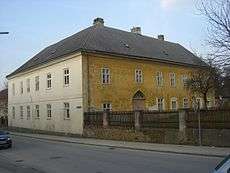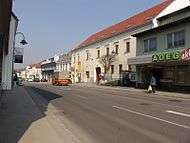Loosdorf
Loosdorf is a little town in the district of Melk in the Austrian state of Lower Austria. One of its historical buildings is the Hohe Schule (translation: the high school) founded in 1574 or a few years earlier by the Austrian nobleman Hans Wilhelm von Losenstein (translated: "John William of Losenstein"), the lord of the nearby castle Schallaburg. It served as a Lutheran grammar school (gymnasium) from about 1574 until 1627.
Loosdorf | |
|---|---|
Church of Saint Lawrence | |
 Coat of arms | |
 Loosdorf Location within Austria | |
| Coordinates: 48°12′N 15°24′E | |
| Country | Austria |
| State | Lower Austria |
| District | Melk |
| Government | |
| • Mayor | Thomas Vasku (SPÖ) |
| Area | |
| • Total | 11.89 km2 (4.59 sq mi) |
| Elevation | 234 m (768 ft) |
| Population (2018-01-01)[2] | |
| • Total | 3,794 |
| • Density | 320/km2 (830/sq mi) |
| Time zone | UTC+1 (CET) |
| • Summer (DST) | UTC+2 (CEST) |
| Postal code | 3382 |
| Area code | 02754 |
| Website | www.loosdorf.at |
Another historical building is the Ledóchowska house, where a.o. blessed Maria Teresia Ledóchowska and Julia, the later Roman Catholic saint Ursula Ledóchowska, were born and where they lived until 1874.
Loosdorf at the end of the 16th century

Around 1574 Hans Wilhem of Losenstein, who lived on the nearby castle Schallaburg, opened a school in Loosdorf, called 'die Hohe Schule' ('the High School'). It started as a private school, esp. for the children of the Lutheran nobility. The statutes of the Lutheran German gymnasium of Loosdorf were printed in Augsburg in 1574. Two original copies still exist. Ytong also printed facsimiles of it in 1974. The school statutes are an important source for the study of the history of pedagogy in Austria. It is regarded as original, although some parts show much resemblance to that of the Lutheran gymnasium of Strasbourg, which in 1621 became the University of Strasbourg. Somer passages are literary the same.
In 1578 Hans Wilhelm von Losenstein, bought agricultural land in Loosdorf and the right to lend out agricultural parcels and to govern Loosdorf.
In 1584 Loosdorf got the right to organize a market.
In 1588 Loosdorf got the right to organize a weekly market, so it got the status of market town (Marktgemeinde).
In 1590 emperor Rudolf II, who was also the archduke of Austria, granted Loosdorf the right of having a municipal coat of arms. The left side is red and has a silver diagonal stripe in the middle. The right side is blue and has a standing gold colored panther that is carrying a torch (see above).
In 1592 the school "Hohe Schule" turned into a school for the nobility of Lower Austria. In 1627 the school had to close. It was one of the last Lutheran schools in Lower Austria until the 19th century. Loosdorf as a consequence did not have a school until 1640, but that school had only two classes then.
Railway station since 1858
In 1858 Loosdorf got a railway station on the line Salzburg-Vienna. Loosdorf then counted about 900 inhabitants.
The Ledóchowska house in Loosdorf from 1862
In 1843 the Austrian Polish count Antoni August Halka Ledóchowski, a brother of the later Archbishop and Cardinal Mieczysław Halka Ledóchowski, acquired the estate Sitzenthal near Loosdorf. He was married to Countess Seilern and they had three sons, Timothy, Anthony, and Casimir. After the early death of his first wife, he married Countess Josephine Salis-Zizers.

In 1862 Anthoni Halka Ledóchowski built a manor house in Loosdorf, where he moved, together with his family.[3] In 1863 Mary Theresa was born in this house. Then followed Julia (later as nun called Ursula), then Wlodimir, Mary, Ernestine, Frances and Ignatius. Two others died soon after their birth.[4]
Due to the bank crash of 1873, Antoni Halka Ledóchowski lost most of his capital, so in 1874 he sold his house in Loosdorf and moved to St. Pölten. Julia and Mary Theresa attended the Institute B.M.V.,[5] then a grammar school for girls run by nuns of the congregation founded by Mary Ward. In April 1882 Count Antoni Halka Ledóchowski acquired an estate in Lipnica in Lower Poland, about 48 km from Cracow. Mary Theresa conducted the renovation and enlargement of the manor house, and in 1883 the family moved there.[6]
In 1883 Julia Halka Ledóchowska became an Ursuline nun in Cracow and after a year she got the name Ursula. She became a missionary in Russia and Scandinavia. She founded the Congregation of the Ursulines of the Agonizing Heart of Jesus, also called the Grey Ursulines, because of their grey habits. Her brother Wlodimir Halka Ledóchowski was the 26th general of the Jesuits. Mary Theresa founded the Soladity of Saint Peter Claver,[7] that acted against slavery in Africa. Ignatius became a general in the Polish army. In 1975 Mary Theresa was beatified by Pope Paul VI. In 1983 Ursula Halka Ledóchowska was beatified too by Pope John Paul II. In 2003 Ursula Halka Ledóchowska was canonized as a Roman Catholic saint by Pope John Paul II.
In 1883 the Ledóchowska House came into the property of the Counts of Montecuccoli. It changed hands several times. From 1928 until 1938 it belonged to the Chamber of Agriculture of Lower Austria, that organized an agricultural winter school in the building. Finally the Soladity of Saint Peter Claver of Salzburg, that was founded by Mary Theresa Ledóchowska, acquired the house.[8]
Fauna
One of the last remaining unrestrained rivers in Austria, River Pielach flows through Loosdorf. The meandering river is home to a multitude of wildlife and the rare Huchen, the Danube salmon.
Industry
Ytong has its Austrian manufacturing in Loosdorf.
Born in Loosdorf
- Ursula Ledóchowska (1865–1939), a Roman Catholic saint
- Maria Teresia Ledóchowska (1863–1922), a Roman Catholic missionary
- Wladimir Ledóchowski (1868–1942), the 26th general of the Jesuits (from 1915 until 1942)
- Ignacy Kazimierz Ledóchowski (1871–1945), a Polish general
- Hans (von) Hammerstein-Equord (1881–1947), Austrian politician and writer
References
- "Dauersiedlungsraum der Gemeinden Politischen Bezirke und Bundesländer - Gebietsstand 1.1.2018". Statistics Austria. Retrieved 10 March 2019.
- "Einwohnerzahl 1.1.2018 nach Gemeinden mit Status, Gebietsstand 1.1.2018". Statistics Austria. Retrieved 9 March 2019.
- {ge} Gerhard Floßmann, "Loosdorf -Ansichten", Loosdorf 1999, p. 59
- Valeria Bielak, "THE SERVANT OF GOD - MARY THERESA COUNTESS LEDÓCHOWSKA - Foundress of the Soladity of Saint Peter Claver", published by the Soladity of St. Peter Claver, Saint Paul, Minnesota, 2nd ed. 1944, p.4
- IBMV stands for 'Institutum Beatae Mariae Virginis', in English it is called IBMV, 'the Institute of the Blessed Virgin Mary'. That was the name of the Institute since 1749. In German it is called 'Institut B.M.V. der Englischen Fräulein'. Since 2004 it is called Institute CJ (Congregatio Jesu).
- Valeria Bielak, "THE SERVANT OF GOD - MARY THERESA COUNTESS LEDÓCHOWSKA - Foundress of the Soladity of Saint Peter Claver", published by the Soladity of St. Peter Claver, Saint Paul, Minnesota, 2nd ed., 1944, p.13-14
- called after Saint Peter Claver
- Dr. Gerhard Floßmann, "Loosdorf - Ansichten", 1999, p. 59
| Wikimedia Commons has media related to Loosdorf. |
